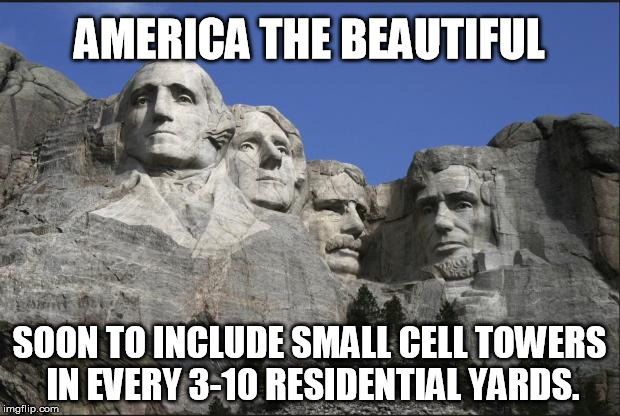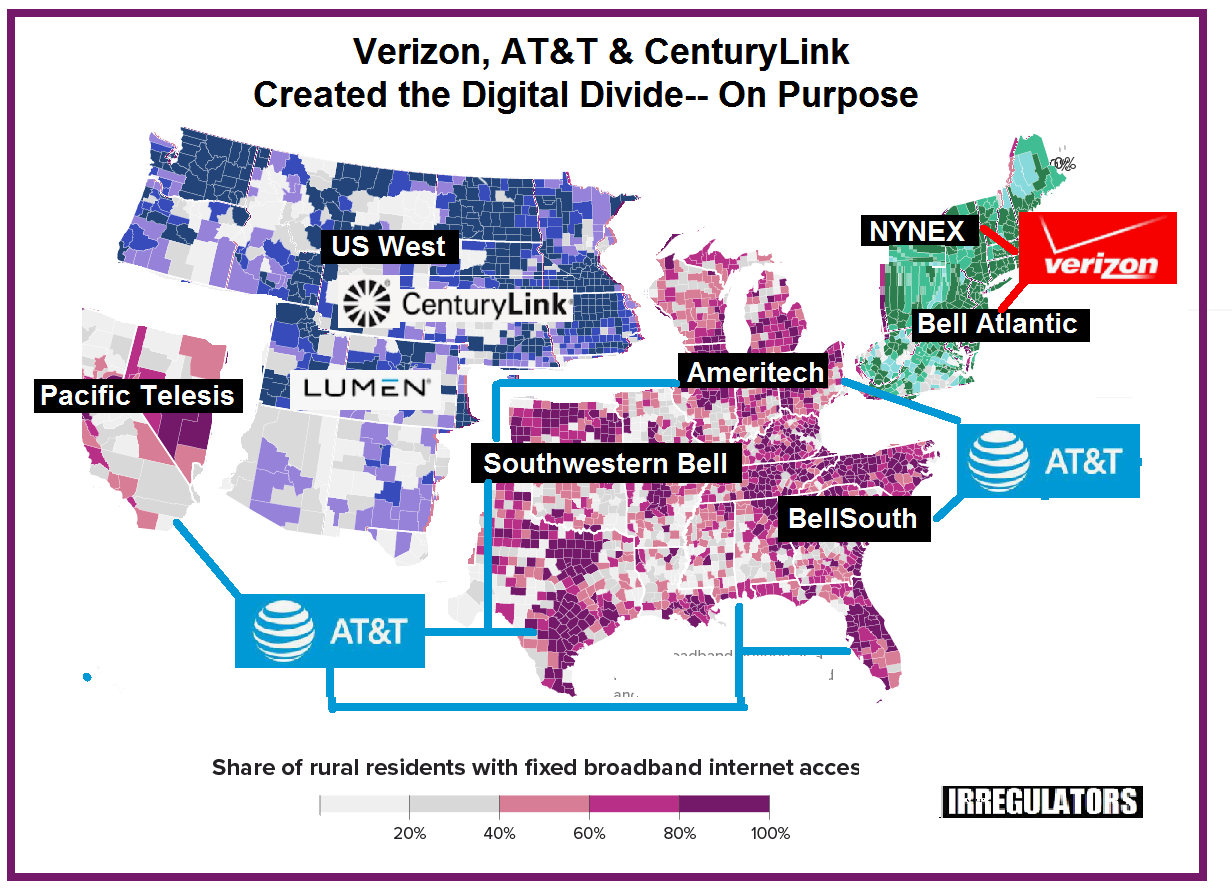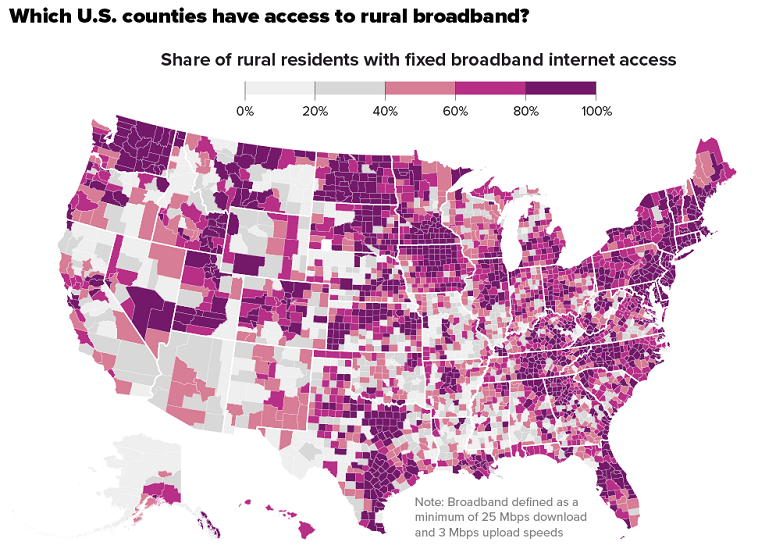 By B.N. Frank
By B.N. Frank
Over the years, numerous lawsuits have been filed against the Federal Communications Commission (FCC) including one by a group of telecom experts, “The Irregulators.” According to the Irregulators’ lawsuit, Americans have already paid for telecom-related services that many have still not received. In fact, for decades, Americans have been overcharged for telecom-related services and we are still being overcharged (see 1, 2, 3, 4). Despite this having been proven, the Biden Administration continues to commit more money to telecom companies which they are using to primarily deploy inferior, unreliable, and unsafe and Wi-Fi and 5G broadband connections instead of safer, more secure, and more reliable fiber optics to the premises (FTTP) and copper landline connections. Thanks to Irregulator Bruce Kushnick for another infuriating “follow the money” exposé.
From Medium:
No Government Subsidies to AT&T, Verizon and CenturyLink: They Created the Digital Divide on Purpose. Where’s All the Money?

PART 2: WHERE ARE THE HUNDREDS OF BILLIONS OF DOLLARS THAT SHOULD HAVE UPGRADED AMERICA’S CRITICAL WIRED INFRASTRUCTURE?
Before 1 cent of new government subsidies is given out, especially to these companies, we want answers to basic questions, a halt to ongoing illegal cross-subsidies and to use these funds to build out the fiber networks BEFORE the government rewards the companies that created the Digital Divide.
====
THIS IS PART 1: PROVE THAT AT&T, VERIZON AND CENTURYLINK (LUMEN) CREATED THE DIGITAL DIVIDE ON PURPOSE.
The map above takes the FCC’s Broadband Availability Map and overlays the coverage areas of AT&T, Verizon and CenturyLink (Lumen) which are holding companies, and these three companies, built out of mergers, control the state telecommunications public utilities service areas. AT&T alone controls 21 states, while Verizon has the East Coast from Massachusetts to Virginia, (and only a part of Connecticut). CenturyLink, now Lumen, controls most of the western states, including Washington and Colorado.
2) Two Quotes: AT&T and Verizon Created the Digital Divide on Purpose.
Here is the admission, in just two quotes, that creation of the Digital Divide was done on purpose — by design — by AT&T and Verizon.
In 2011, over a decade ago, Verizon announced that it was no longer going to build out their high-speed broadband deployments, FiOS, and would handle the remaining areas, about 35% of their service areas, with wireless; At the same time, AT&T controlled 22 states, (which included SNET, Connecticut) and claimed it was done with the U-verse broadband deployments and that 55% was covered. And both companies had the same subplot — push customers onto wireless cellular service so that they wouldn’t have to upgrade the rural territories.
But the key here: The pandemic exposed that there was a Digital Divide that was much larger and deeper than previously recognized and that wireless was NOT a substitute for a wired, high-speed connection to the home or business. Kids couldn’t do their homework on a smartphone; the speed wasn’t there and there are data-caps, making it too expensive to use like a wired high-speed connection.
=======
Quote 1: Verizon’s former CFO, Fran Shammo, Verizon Communications Inc. announced at an investor event in 2011 that their planned fiber optic build out, known as FiOS, was completed and that there were no fiber buildout plans for about 6.5 million households in their state service areas.
“I think that we are very, very satisfied with the portfolio at this point. I can’t say that we are actively trying to divest of anything at this point in time. I would say that from a homes passed perspective as we continue with FiOS, we will continue to pass the 18 million homes. We will have about 6 million to 7 million we won’t pass at this point. It doesn’t mean that we will never pass them. But I think we owe it to our investors at this point to return the investment on where we have put into the ground from a FiOS perspective. Now, having said that, I think that with the wireless, with LTE, I think it brings a lot more opportunity of how we bundle these products to offer the outside of the FiOS footprint and some innovative things that we can do around LTE, along with the wireline products to create some very specialized bundles for these customers. So, at this point we are not looking to divest anymore.”
AT&T, at this same time, was claiming that it, too, had finished their planned deployments of U-verse and were now going to substitute wireless. DSLReports detailed in 2011, that AT&T’s then president claimed it would be halting any high-speed broadband in many of their service areas.
“During a recent Citibank investor’s conference, John Stankey, AT&T’s President, said that the service provider is confident it can pass 55–60 percent of the 30 million homes passed in their service region by end of 2011. But that may be the end of the line for U-verse.
“Within the broadband data realm, Stankey said that only 25–30 percent of homes in AT&T’s region will be offered ADSL, adding that 20 percent of them are ‘not a heavy emphasis for investment’.”
These two quotes — by Verizon and AT&T — that they were not upgrading their entire service regions with FiOS or with U-verse and would substitute wireless, sealed the fate of rural communities and low income urban areas throughout America, as these quotes and others indicate that around 1/3 of the entire Verizon territories would not be properly upgraded to fiber, and ½ of the AT&T territories.
A Few Points:
First, the numbers provided by AT&T and Verizon for their deployments and coverage areas were never accurate. There were no audits or investigations of the actual deployments over the last decade, and Verizon’s fiber to 18 million homes had serious flaws — while the coverage, when examining the details, appeared to be less than 50% in most states.
Second, our research indicated that the monies collected and overcharged from 1993–2020 by AT&T, Verizon and CenturyLink was over $½ trillion dollars. Starting in 1992, state laws were changed to give the companies more profits and tax perks to do the buildouts for fiber multiple times — and these profits were essentially merely rate increases. As we discuss in Part 2, not only were their specific rate increases supposed to be tied to the broadband deployments, but, the prices for all communications services should have been in steep decline.
Third, from 2010–2021, according to Verizon Communications, Inc. Annual Reports, Verizon’s FiOS deployments were a trickle. In 2010, Verizon had 4.8 million internet connections; by 2019, Verizon had only 5.9 million FiOS internet connections, which is only 1 million additions for over a decade; the pandemic through 2021 appears to have helped adding 600K since 2019. However, at the same time, the ‘video’ connections went down, from 4.2 million in 2010 to 3.6 million in 2021, a loss of 600,000 customers. With little or no serious expansion, and taking the money to buy media and advertisement companies, such as AOL and Yahoo, both of which lost billions, there was no effort to seriously expand the fiber optic services to the home, especially in rural or low income areas.
Finally, these companies are NOT ISPs, which is a service that connects a customer to the Internet and World Wide Web; they are actually a collection of state-based public telecommunications utilities, (also called “Incumbent Local Exchange Companies”, “ILECs”), and they controlled the physical wires and technological infrastructure. These corporations, which are Holding Companies, have separate subsidiaries that provide multiple services such including access to the Internet, thus they claim to be “ISPs”. This is an important distinction as it leads to the financials books and the flows of money — which shows that their subsidiary ISPs have been getting financial advantages for decades.
Shut Off the Copper, Force-March Customers to Wireless
These quotes were the start; the rest of this marketing campaign played out throughout the rest of the decade.
“Cut the copper off,” Lowell McAdam, Chairman and CEO of Verizon Communications, speaking at the Guggenheim Securities Symposium, June 21, 2012
“And then in other areas that are more rural and more sparsely populated, we have got LTE [Verizon Wireless] built that will handle all of those services, and so we are going to cut the copper off there. We are going to do it over wireless. So, I am going to be really shrinking the amount of copper we have out there, and then I can focus the investment on that to improve the performance of it.”
In AT&T’s 2012 announcement of its “VIP plan”, AT&T claimed that it would have 75% of their territories covered with wireline broadband networks by the end of 2015.
“AT&T plans to expand and enhance its wireline IP network to 57 million customer locations (consumer and small business) or 75 percent of all customer locations in its wireline service area by year-end 2015.”
25% of AT&T’s territories would be wireless because it was not ‘economically feasible’ to build this IP broadband network.
“In the 25 percent of AT&T’s wireline customer locations where it’s currently not economically feasible to build a competitive IP wireline network, the company said it will utilize its expanding 4G LTE wireless network — as it becomes available — to offer voice and high-speed IP Internet services.”
And there you have it — the companies admitting that they were going to let the entire US wired copper infrastructure deteriorate, that it was being replaced by wireless in rural areas and that included low-income urban neighborhoods and other ‘non-performing areas’.
They Knew They Were Illegally Diverting the Wireline Construction Budgets to Wireless
In 2012, Fran Shammo, former Verizon CFO told investors that the wireless company’s construction expenses have been charged to the wireline business division.
“The fact of the matter is Wireline capital — and I won’t get the number but it’s pretty substantial — is being spent on the Wireline side of the house to support the Wireless growth. So, the IP backbone, the data transmission, fiber to the cell, that is all on the Wireline books but it’s all being built for the Wireless Company.”
NY Attorney General Found the Cross-Subsidies, but Did Not Act
In 2012, the NY Attorney General confirmed that wireless and FiOS cable were funded via the state intrastate telephone utility construction budgets. In 2011, Verizon NY stated that the company spent over $1 billion on the utility capital investment. The NY Attorney General claimed that 75% of this construction budget did not go to maintaining and upgrading the copper telephone network but rather for the buildout of the fiber optic network for the company’s other lines of business, including wireless and for FiOS, which is a ‘cable TV service’, as stated in the franchises granted in NY.
“Verizon NY’s claim of making over a ‘billion dollars’ in 2011 capital investments to its landline network is misleading. In fact, roughly three- quarters of the money was invested in providing transport facilities to serve wireless cell sites and its FiOS offering. Wireless carriers, including Verizon’s affiliate Verizon Wireless, directly compete with landline telephone service and the company’s FiOS is primarily a video and Internet broadband offering.”
Verizon’s message to the public has been that 5G and wireless would replace the wired networks; to the investors it is — Get rid of ‘labor intensive’ activities and lower expenses. Lowell McAdam, at the May 24, 2016 event:
“So if you think about it if I can get we than say a 1000 meters of a business and I give them a router, a basic router that has a 5G service inside it and I’m up and operating immediately, I mean, think about the difference for the carrier in the cost structure; half of our cost to establish high speed data whether it’s consumer business is inside the four walls of the business. ‘Once you go wireless, you don’t have to run co-ax, you don’t have to do any of those high labor intensive activities and so you light up service overnight. So then you get into how much capacity do you want and you can — the pricing models can change dramatically’.”
The Maps Show the Digital Divide. Now We Know Who Is to Blame for It.
The FCC has not taken the maps of AT&T, Verizon and CenturyLink (Lumen) territories and overlaid them with the maps showing the unserved areas. This map shows that the failure to properly upgrade the states’ wired public utility infrastructure caused the Digital Divide- and these quotes, discussing Verizon and AT&T’s discontinuation of the buildout from their wireline broadband and illegally diverting the construction budgets to deliver slow and expensive wireless — makes clear that all of this was done by design — on purpose.
For the record, this is what the original FCC map looked like using 2016 data, showing the gaps in deployment based on a defined broadband speed of 25Mbps download and 3Mbps upload.

But the Government Maps are Missing Critical Information and Breakouts.
There is supposedly a set of new maps being developed, but it will leave out basic critical facts.
- This map and data show that AT&T et al. created the holes.
- Where are the separate maps for AT&T, Verizon and CenturyLink for coverage speeds?
- Where is the mention that there are state telecom public utilities, which had obligations to do upgrades of their service territories?
- Where is the detailed chart of the amount of money collected in the name of previous rate increases for broadband buildout?
- Where is a detailed chart of the previous financial commitments for fiber optics?
- Where are the maps that document which unserved areas of AT&T et al. have already received federal and state funding to close the Digital Divide?
- Why are the maps presented combining all of the companies, so that it hides what their actual deployments are?
And what happens when we remove the cable companies’ broadband deployments from these Digital Divide maps?
ILSR has been tracking the basic broadband deployments of the cable and phone companies.
“At least 49.7 million Americans only have access to broadband from one of the seven largest cable and telephone companies. In total, at least 83.3 million Americans can only access broadband through a single provider.
“Comcast and Charter maintain an absolute monopoly over at least 47 million people and another 33 million people only have slower and less reliable DSL as a ‘competitive choice’.”
This means that the holes presented are much worse as there should be at least two or more companies in each area; the word “competition” comes to mind. But more importantly, we didn’t pay $½ trillion dollars so that AT&T et al. could be a no-show. The cable companies and the phone companies were supposed to be competing, not colluding.
It is because there is no serious competition that America’s prices are 5–20 times more expensive for communications, The US average price of the triple play — phone, broadband and cable TV was $217 accounting to Consumer Reports for 2019; According to the EU Commission report of 2021, the average price is about $37 a month.
And the affordability of service is also at the core of this Digital Divide.
Finally, our map shows who to blame for the Digital Divide. AT&T et al. let the entire US wired copper-based infrastructure deteriorate.
PART 2: The real question is — If the companies halted their deployments for high-speed broadband in 2011, where are the billions of dollars collected by the state utilities in the name of the buildout of the broadband infrastructure?
It is time to follow the money trail. We contend that there are hundreds of billions of dollars that should have been used for a fiber optic future for everyone, everywhere, which was instead spent on wireless and other lines of business. And it continues today.
Our position is, again:
“Before one cent of new government subsidies are given out, especially to these companies, we want answers to basic questions, a halt to ongoing illegal cross-subsidies and to use these recovered funds BEFORE the government rewards the companies that created the Digital Divide.”
New Networks Institute, Executive Director, & Founding Member, IRREGULATORS; Telecom analyst for 38 years, and I have been playing the piano for 63 years.
Activist Post reports regularly about the FCC, government corruption, and unsafe technology. For more information visit our archives and the following websites.
Become a Patron!
Or support us at SubscribeStar
Donate cryptocurrency HERE
Subscribe to Activist Post for truth, peace, and freedom news. Follow us on SoMee, Telegram, HIVE, Flote, Minds, MeWe, Twitter, Gab, What Really Happened and GETTR.
Provide, Protect and Profit from what’s coming! Get a free issue of Counter Markets today.

Be the first to comment on "Following the Money: Billions Already Given to Telecoms that Deliberately Created the “Digital Divide,” Continue to Harm Americans"